Engaging in fun activities that stimulate fine motor skills can significantly boost your child’s development. Try sticker activities, which enhance visual motor coordination, strengthen hand muscles, and tap into creativity. Stringing and paper activities build muscle memory and coordination while adapting to your child’s skill level. These fun fine motor skill exercises keep children engaged and learning.
Coin activities help refine precision grasping and finger strength, while clothespin activities offer a fun way to improve body awareness and foster problem-solving skills. These fun fine motor skills activities make learning enjoyable and beneficial. Explore these activities to discover their detailed benefits and how they can help your child’s development.
Key Takeaways
- Sticker activities encourage fine motor skills and hand-eye coordination, making them a fun and educational activity for children.
- Stringing activities, such as bead threading, boost precision grasp, bilateral integration, and muscle memory.
- Paper activities, including tearing or cutting, foster creativity and refine fine motor control, hand strength, and coordination.
- Coin activities like sorting and stacking can build pincer grasp, visual motor coordination, and hand strength.
- Creative clothespin activities enhance fine motor development, body awareness, and dressing skills and foster problem-solving abilities.
Exploring Sticker Activities
Delving into the world of sticker activities, children can enhance their fine motor skills, hand-eye coordination, and muscle strength in a fun and engaging manner. These activities promote the pincer grasp, a vital child’s motor development milestone. Children improve their fine motor skills and visual motor coordination by peeling stickers off their hands or clothing and placing them on designated spots.
Another critical aspect of these activities is the strategic placement of stickers. For instance, drawing open circles on paper for sticker placement enhances hand-eye coordination and precision, offering an enjoyable and effective way to reinforce these skills. The repeated action of peeling and placing stickers also strengthens the hand muscles, improving talent in an exciting and alluring way.
The beauty of sticker activities lies in their versatility. They can be easily personalized to suit different skill levels, providing a creative outlet for children to explore and develop their fine motor skills. Whether creating a colorful collage or completing an intricate pattern, the possibilities are as infinite as they are beneficial.
Fun With Stringing Activities
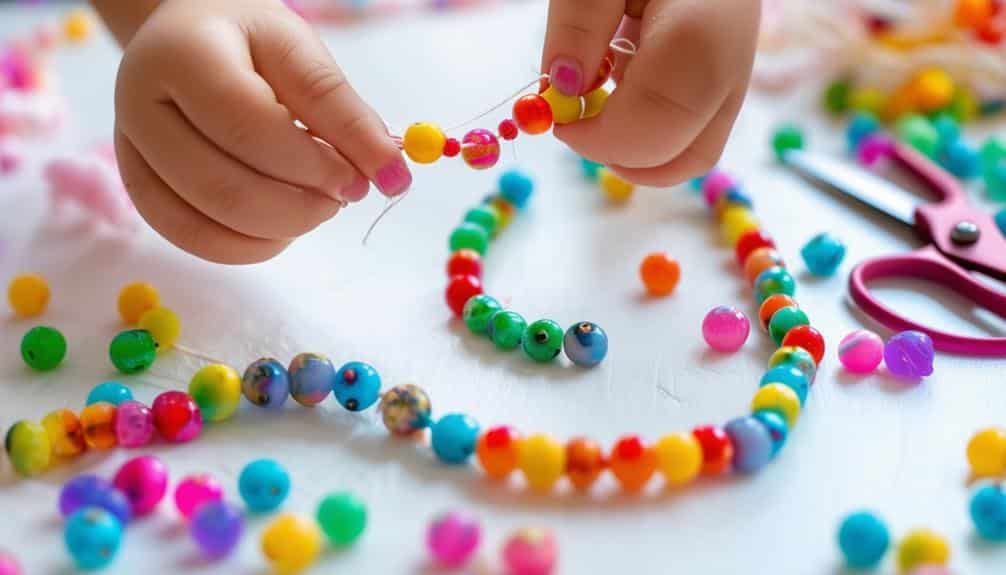
Often overlooked, stringing activities offer a dynamic and engaging way to foster hand-eye coordination and fine motor skills in children. These activities involve motor operations that require precision grasp, bilateral integration, finger dexterity, and two-handed coordination. Threading beads or cereals like Cheerios onto a string or pipe cleaners keeps children entertained and helps them develop fine motor skills essential for their growth and learning.
Stringing activities are particularly advantageous in the following ways:
- They develop muscle memory. The repetition of threading helps children build up muscle memory, which is essential for mastering other daily tasks.
- They enhance precision grasp. The necessity of gripping small objects like beads promotes the development of a precise grasp.
- They promote bilateral integration. Using both hands coordinated during stringing activities encourages bilateral integration, a specific skill for writing, eating, and tying shoelaces.
Starting with larger beads and gradually moving on to smaller ones can challenge and improve the child’s hand and finger strength. So, let’s grab some beads and pipe cleaners and start having fun while boosting your child’s development.
Engaging in Paper Activities
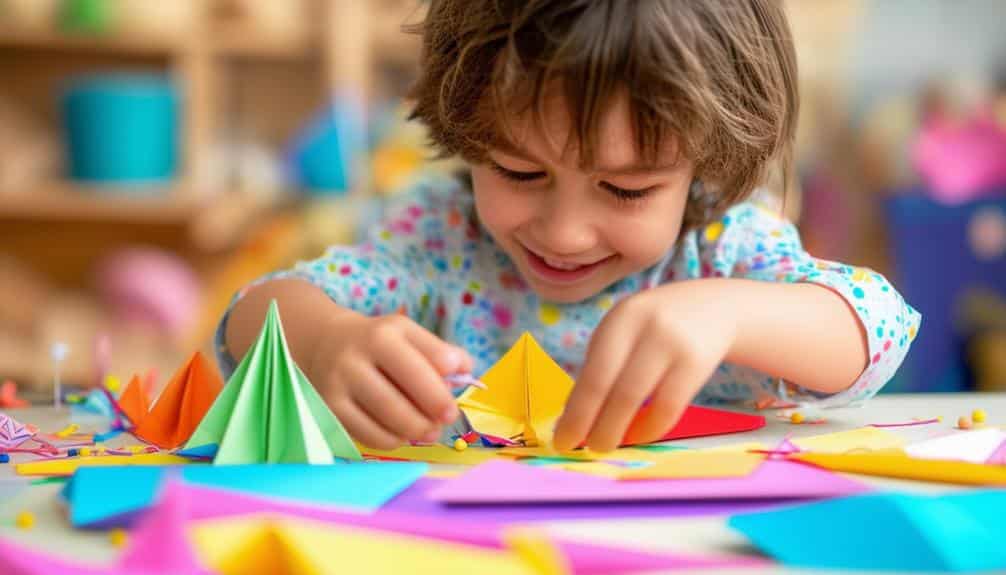
Paper activities are versatile tools for fine motor skill development. They offer various engaging tasks to enhance children’s hand strength, coordination, and creativity. Simple actions like ripping or crumpling paper fuel kids’ imagination and aid in developing hand strength and fine motor coordination.
Creating mosaic crafts by tearing or cutting paper promotes the bimanual tripod grasp, an essential fine motor skill required for writing. This activity also enhances hand-eye coordination, a critical aspect of fine motor skills activities. Encouraging children to follow patterns or shapes when cutting with scissors further refines their fine motor control and hand strength.
Paper activities are adaptable and can cater to different skill levels and age groups. Whether cutting out basic shapes or intricate designs, children can work at their own pace. Through these age-appropriate paper activities, children gain fine motor skills and learn about creativity and adaptability, crucial life skills that will serve them well. Remember, the goal is to make the learning process enjoyable and productive.
Coin Activities for Skill Development
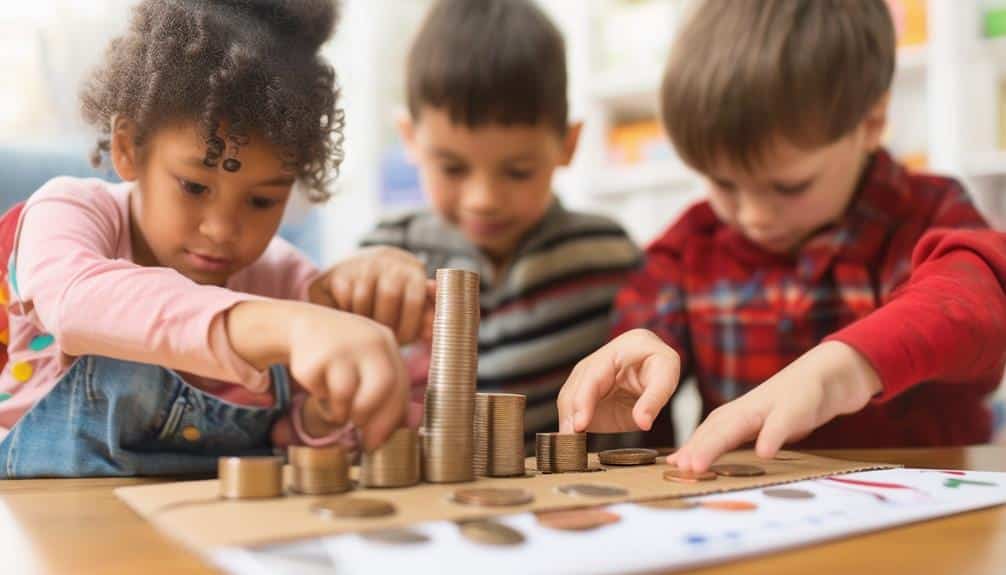
Harnessing the potential of everyday objects, coin activities present a unique opportunity for children to build their pincer grasp and visual motor coordination. These activities promote fine motor skills and hand and finger strength, crucial for everyday tasks.
Children can engage in activities such as sorting coins by type or size, promoting visual motor coordination. Stacking coins of varied sizes and weights can enhance precision grasp. Simple tasks like placing coins in a piggy bank or coin slot can provide engaging hands-on tasks while fostering skill development.
The beauty of coin activities lies in their adaptability. They can be scaled to suit a range of abilities, from toddlers just starting to explore their motor abilities to older children looking to refine their skills.
Here are some activities that can be performed:
- Sorting coins: This increases visual motor coordination and precision grasp.
- Stacking coins: This activity can boost hand and finger strength.
- Placing coins in a piggy bank: This fun task can develop a pincer grasp.
While simple, these coin activities provide a rich source of skill development opportunities adapted for different age groups.
Creative Clothespin Activities
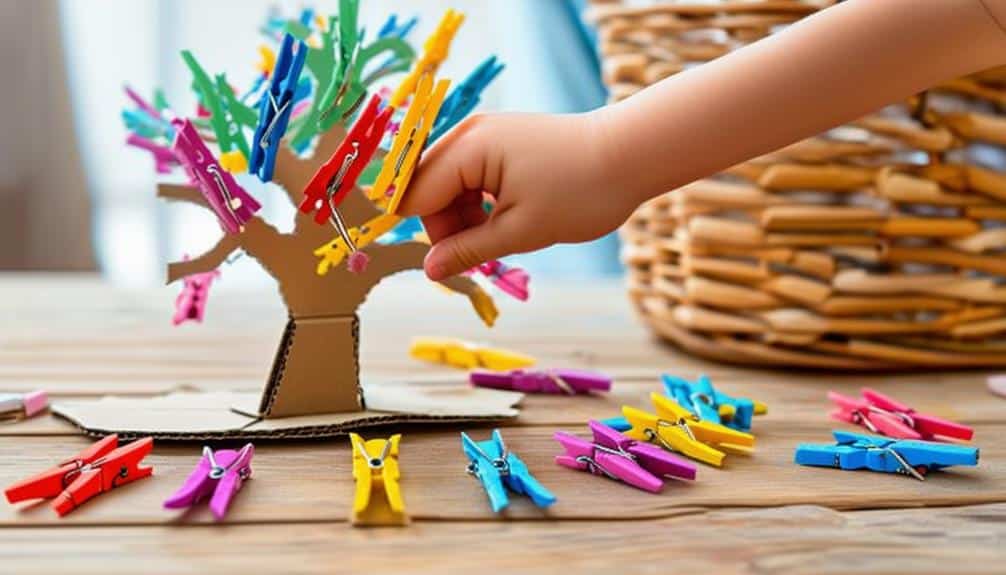
Exploring the domain of creative clothespin activities can immensely benefit children’s fine motor development, boosting hand strength and precision grasp through fun and interactive tasks. These activities are a fantastic way to combine fine motor fun with learning as your child navigates the small yet challenging task of maneuvering clothespins.
One idea involves attaching clothespins to the edges of sturdy board books. This not only promotes fine motor coordination but also sparks their creativity. Please encourage your child to create their patterns or sequences, fostering their problem-solving skills while building hand muscles.
Another practical idea is to use clothespins on clothing, which enhances body awareness. This simple activity supports independent dressing skills and simulates the movements required in buttoning or unbuttoning clothes.
Lastly, attaching clothespins to objects around the house or in nature can considerably develop your child’s hand-eye coordination. The child must focus on the object while controlling the clothespin’s movement.
Frequently Asked Questions
What Activities Help Children Develop Fine Motor Skills?
Fine motor skills can be enhanced in children through activities like manipulating play dough, beading, painting rocks, sticker fun, cutting practice, button sorting, paper tearing, Lego building, threading beads, and play dough stamping.
What Are 5 Fun Fine Motor Skills?
What are five vital fine motor skills? Pincer grasp, hand-eye coordination, finger dexterity, writing skills, and scissor cutting are fundamental. These skills are pivotal in bead threading, Playdough sculpting, buttoning clothes, Lego building, and tweezer activities.
What Is the Best Way to Develop Fine Motor Skills of a 4-Year-Old?
Promote a 4-year-old’s development of fine motor skills through engaging activities like play dough manipulation, scissor skill exercises, bead threading, finger painting, buttoning garments, Lego building, coloring pages, sticker art, and the use of play tools.
What Fine Motor Activities Are Good Practice for Children Ages Four to Six?
For children aged four to six, fine motor activities such as coloring challenges, playdough fun, scissor skills, Lego building, button sorting, bead threading, pencil grip exercises, sticker art, tweezer challenges, and pasta threading are beneficial.

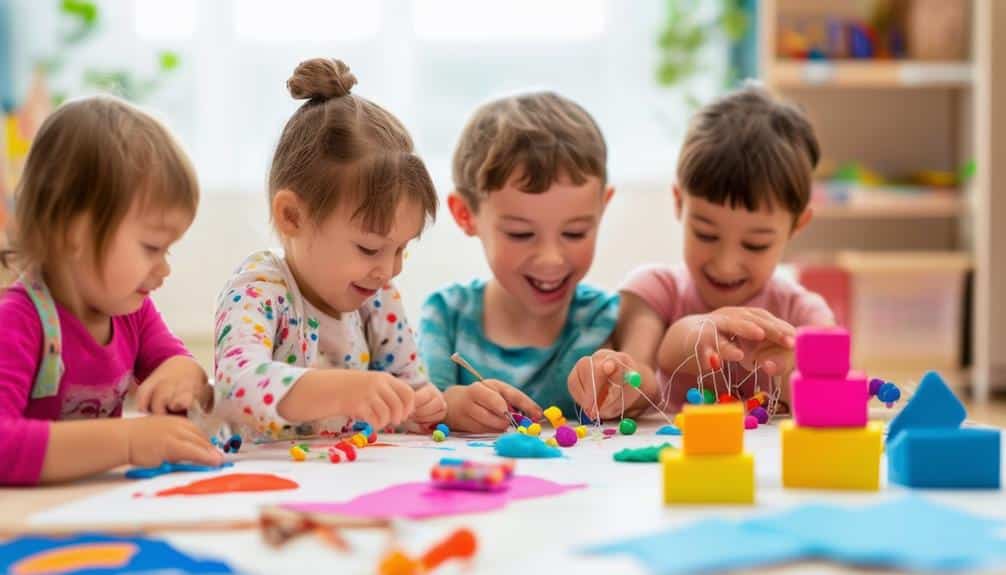
Recent Comments